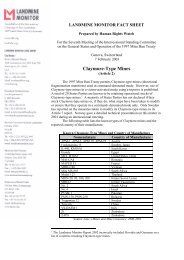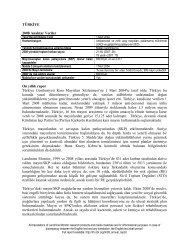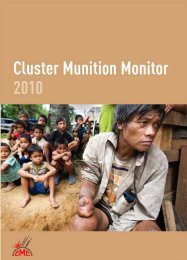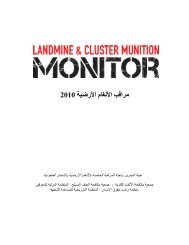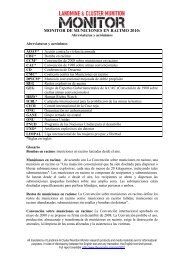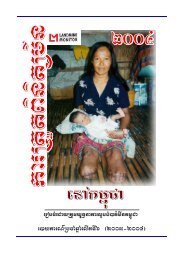Download PDF - Landmine and Cluster Munition Monitor
Download PDF - Landmine and Cluster Munition Monitor
Download PDF - Landmine and Cluster Munition Monitor
You also want an ePaper? Increase the reach of your titles
YUMPU automatically turns print PDFs into web optimized ePapers that Google loves.
<strong>Cluster</strong> <strong>Munition</strong> <strong>Monitor</strong> 2012<br />
• Lao PDR is the world’s most heavily cluster munition-contaminated country. The US dropped more than<br />
270 million submunitions between 1964 <strong>and</strong> 1973. 20 There is no agreed estimate of the true extent of residual<br />
contamination from unexploded submunitions, but close to 70,000 cluster munition strikes have been identified,<br />
each with an average strike “footprint” of 125,000m2. In September 2011, Lao PDR claimed that a rough<br />
estimate of cluster munition contamination at the end of the war was of 8,750km 2 . 21 According to the National<br />
Regulatory Authority (NRA), 10 of Lao PDR’s 17 provinces are “severely contaminated.” The NRA is planning<br />
a district-level survey of cluster munition contamination with three operators (H<strong>and</strong>icap International<br />
(HI), Mines Advisory Group (MAG), <strong>and</strong> NPA) to try to get a more precise determination of the extent of the<br />
problem. The survey is being piloted in three districts before it is eventually extended to cover all 85 districts<br />
affected by unexploded ordnance (UXO). 22<br />
• Lebanon’s cluster munition contamination originates primarily from the July–August 2006 conflict with<br />
Israel, but parts of the country remain affected from cluster munitions used in the 1980s. As of April 2012,<br />
17.86km 2 was suspected to be contaminated by cluster munition remnants, across 449 SHAs. 23 This represents<br />
a small decrease on the estimate of 18.1km 2 as of May 2011.<br />
• Mauritania has at least five areas containing cluster munition remnants, which are all located some 30–35km<br />
north of the village of Bir Mogrein. 24 The first contaminated area to be identified covers approximately 6km 2 ,<br />
although further survey is likely to reduce the size of the area. 25 The second area, which is located nearby,<br />
covers some 3km 2 . 26 As yet, there is no formal estimate of the size of the three other contaminated areas.<br />
• Montenegro did not declare any contaminated areas in its initial Article 7 report, but in July 2011, the director<br />
of the Regional Centre for Divers’ Training <strong>and</strong> Underwater Demining (RCUD) confirmed a possible<br />
threat from the presence of unexploded BLU-97 submunitions, mainly at Golubovci airfield near the capital<br />
Podgorica. 27 The contamination, which is estimated to cover 250,000m2, 28 is believed to affect four villages<br />
around the airport. 29 In April 2012, Montenegro informed States Parties that it was contaminated by cluster<br />
munition remnants left over from conflict in the 1990s <strong>and</strong> claimed that since 1999 clearance of “several<br />
locations” had not been conducted “fully according to humanitarian mine action st<strong>and</strong>ards.” Montenegro<br />
planned to conduct survey of the areas “in the coming period” to identify the size of the contaminated areas,<br />
but provided no further details. 30<br />
• Norway reported in January 2011 that the Hjerkinn firing range is contaminated by an estimated 30 unexploded<br />
DM 1383/DM 1385 submunitions. 31 In June 2011, it stated that the affected area was 0.84km 2 . 32 In<br />
April 2012, Norway stated that clearance of the area is continuing <strong>and</strong> expected to be completed in 2013. 33<br />
Signatories<br />
Three signatories are believed to be contaminated with cluster munition remnants: Chad, the Democratic Republic of the<br />
Congo (DRC), <strong>and</strong> Iraq.<br />
• Chad is contaminated by cluster munition remnants, but the precise extent remains to be determined. In December<br />
2008, Chad stated it had “vast swathes of territory” contaminated with “mines <strong>and</strong> UXO (munitions<br />
<strong>and</strong> submunitions).” 34 MAG found unexploded Soviet PTAB-1.5 submunitions close to Faya Largeau during<br />
a 2010–2011 re-survey of mine <strong>and</strong> ERW contamination. 35<br />
• In DRC, cluster munition remnants have been found in the provinces of Equateur, Katanga, Maniema, <strong>and</strong><br />
Orientale, while North Kivu province is also suspected to be contaminated. 36 In April 2011, the UN Mine Action<br />
Coordination Center, DRC (UNMACC) reported 18 sites in which submunitions had been found, most<br />
20<br />
“US bombing records in Laos, 1964–73, Congressional Record,” 14 May 1975.<br />
21<br />
Statement of Lao PDR, Convention on <strong>Cluster</strong> <strong>Munition</strong>s Second Meeting of States Parties, Beirut, 14 September 2011.<br />
22<br />
NRA, “National Regulatory Authority for UXO/Mine Action in Lao PDR,” www.nra.gov.la.<br />
23<br />
Presentation by Maj. Pierre Bou Maroun, Head of Regional Mine Action Center (RMAC), Nabatiye, 3 May 2012.<br />
24<br />
Observations during <strong>L<strong>and</strong>mine</strong> <strong>and</strong> <strong>Cluster</strong> <strong>Munition</strong> <strong>Monitor</strong> field mission, Bir Mogrein, 26 April 2010.<br />
25<br />
Ibid.<br />
26<br />
Email from Alioune O. Mohamed El Hacen, PNDHD, 20 April 2011.<br />
27<br />
Telephone interviews with Veselin Mijajlovic, Director, RCUD, 19 <strong>and</strong> 25 July 2011.<br />
28<br />
“Field of Golubovac, Reconnaissance, Survey, <strong>and</strong> Removal of <strong>Cluster</strong> Bombs, Estimated Expenses,” Podgorica, 21 February 2009, received<br />
by email from Veselin Mijajlovic, RCUD, 26 March 2009.<br />
29<br />
Interview with Borislav Miskovic, Head of Explosive Ordnance Disposal Team, Montenegro Police Force, Podgorica, 16 March 2008.<br />
30<br />
Statement of Montenegro, Convention on <strong>Cluster</strong> <strong>Munition</strong>s Intersessional Working Group on Clearance <strong>and</strong> Risk Reduction, Geneva, 17<br />
April 2012.<br />
31<br />
Norway, Convention on <strong>Cluster</strong> <strong>Munition</strong>s Article 7 Report, Form F, 27 January 2011.<br />
32<br />
Statement of Norway, Convention on <strong>Cluster</strong> <strong>Munition</strong>s Intersessional Meetings, Session on Clearance <strong>and</strong> Risk Reduction, Geneva, 28 June<br />
2011. Notes by CMC.<br />
33<br />
Statement of Norway, Convention on <strong>Cluster</strong> <strong>Munition</strong>s Intersessional Working Group on Clearance <strong>and</strong> Risk Reduction, Geneva, 17 April<br />
2012. Notes by CMC.<br />
34<br />
Statement of Chad, Convention on <strong>Cluster</strong> <strong>Munition</strong>s Signing Conference, Oslo, 3 December 2008.<br />
35<br />
Email from Liebeschitz Rodolphe, Chief Technical Advisor, UNDP, 21 February 2011; <strong>and</strong> email from Bruno Bouchardy, Program Manager,<br />
MAG Chad, 11 March 2011.<br />
36<br />
Email from Charles Frisby, Chief of Staff, UNMACC, DRC, 30 March 2011.<br />
44



